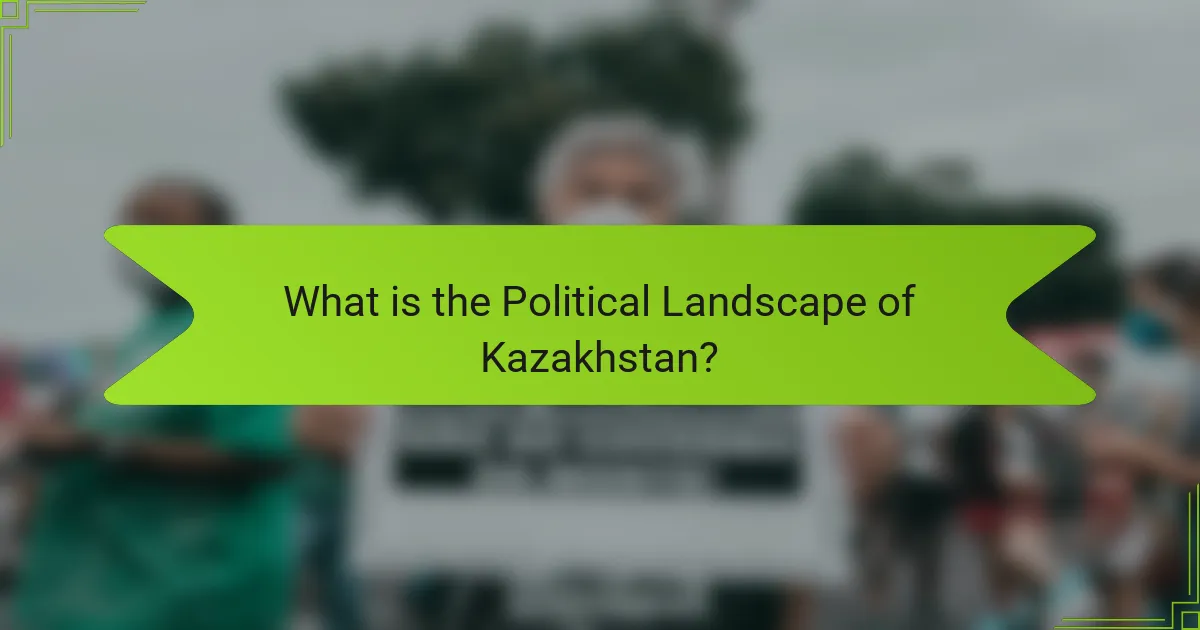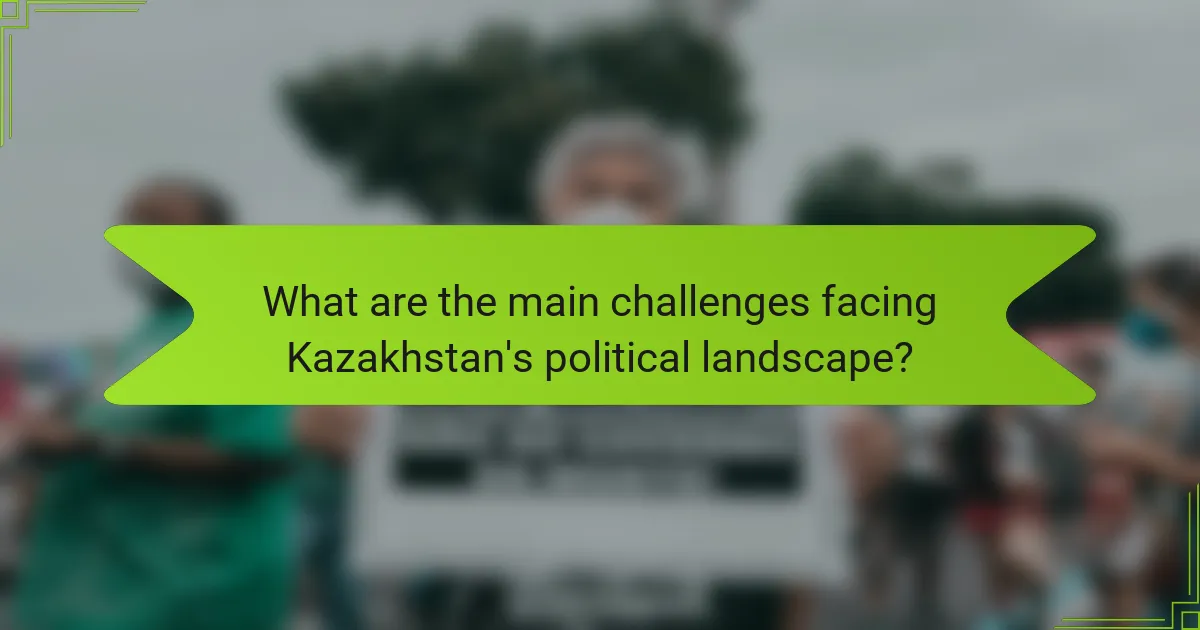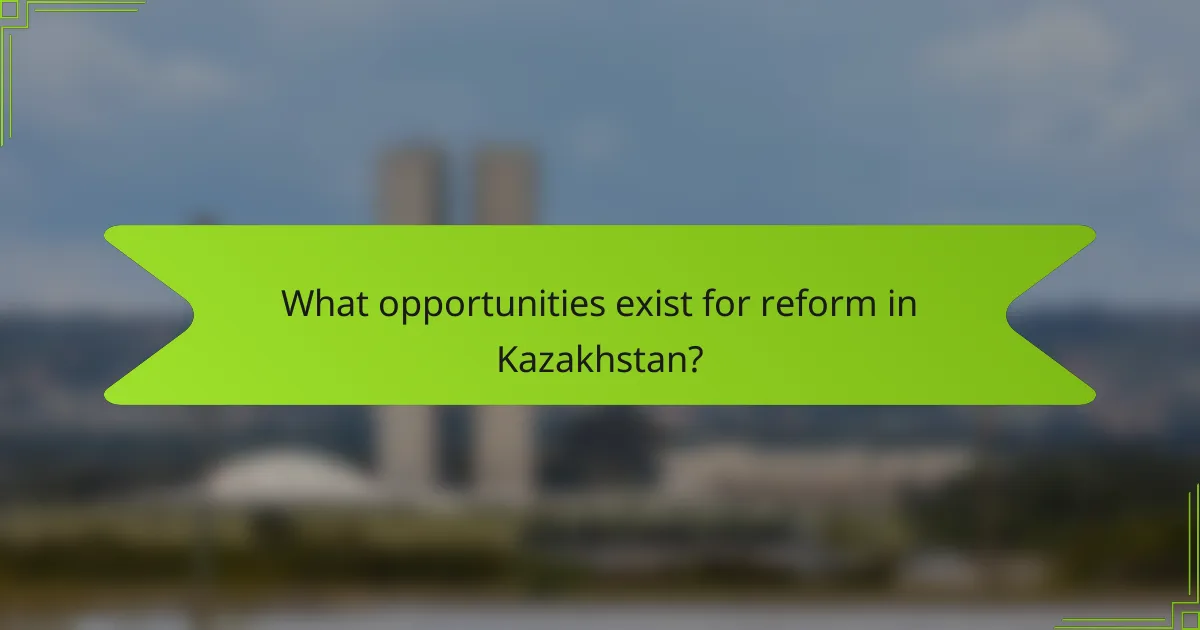The political landscape of Kazakhstan is defined by its presidential republic framework, with significant executive power held by the President, currently Kassym-Jomart Tokayev. Historically, the ruling party, Nur Otan, has dominated the political scene, established by former President Nursultan Nazarbayev. Recent years have seen calls for political reforms amid challenges related to governance, political repression, and corruption, particularly highlighted by protests in January 2022. The article explores the ongoing transition in leadership, the government’s proposed reforms for political pluralism, and the socio-economic disparities affecting stability. Additionally, it discusses potential opportunities for reform in governance, economic diversification, and civil society engagement to promote democratic participation and enhance transparency.

What is the Political Landscape of Kazakhstan?
The political landscape of Kazakhstan is characterized by a presidential republic framework. The President holds significant executive power and is the head of state. Kazakhstan’s political system has historically been dominated by the ruling party, Nur Otan, which was founded by former President Nursultan Nazarbayev.
In recent years, there have been calls for political reforms and increased democratization. The government has faced challenges regarding political freedoms and human rights. Protests erupted in January 2022, highlighting public dissatisfaction with economic conditions and governance.
Kazakhstan’s political environment is influenced by its strategic location and relationships with neighboring countries. The country balances ties with Russia, China, and Western nations. The ongoing transition of leadership after Nazarbayev’s resignation in 2019 marks a significant change in the political landscape.
The current President, Kassym-Jomart Tokayev, has initiated some reforms aimed at addressing these challenges. His administration has proposed constitutional amendments to enhance political pluralism. However, the effectiveness and sincerity of these reforms remain subjects of debate among analysts and the public.
How has the political landscape evolved over time?
The political landscape of Kazakhstan has evolved significantly since its independence in 1991. Initially, Kazakhstan maintained a strong presidential system under Nursultan Nazarbayev. His leadership emphasized stability and economic growth, often at the expense of democratic freedoms. Over the years, there has been a gradual shift toward political pluralism. In 2019, Nazarbayev resigned, marking a pivotal moment in Kazakhstan’s political evolution. His successor, Kassym-Jomart Tokayev, introduced reforms aimed at increasing political participation. These reforms included the establishment of new political parties and a commitment to holding more transparent elections. Public protests in 2021 highlighted growing demands for political change. The government’s response to these demands will shape the future political landscape. Overall, Kazakhstan’s political evolution reflects a complex interplay of stability, reform, and public aspirations for democracy.
What historical events have shaped Kazakhstan’s political framework?
Kazakhstan’s political framework has been shaped by several key historical events. The establishment of the Kazakh SSR in 1936 marked the beginning of Soviet influence. This period included significant repression and forced collectivization, impacting governance structures. The independence of Kazakhstan in 1991 led to the formation of a sovereign state. Nursultan Nazarbayev became the first president and implemented reforms to strengthen the executive branch. The 1995 Constitution established a presidential republic, centralizing power. The 2011 Zhanaozen protests highlighted social discontent and calls for political reform. Recent efforts for modernization have aimed to diversify governance and enhance civil society engagement. These events collectively influence Kazakhstan’s ongoing political evolution.
How have leadership changes influenced political dynamics?
Leadership changes in Kazakhstan have significantly influenced political dynamics. The transition from Nursultan Nazarbayev to Kassym-Jomart Tokayev marked a shift in governance style. Tokayev’s leadership has introduced reforms aimed at decentralizing power. These reforms have aimed to increase public participation in governance. Additionally, leadership changes have affected the balance of power among political factions. The new leadership has also responded to public protests with a more conciliatory approach. This shift has altered the public’s perception of government legitimacy. Historical context shows that leadership transitions often lead to shifts in policy direction and public sentiment. For example, Tokayev’s focus on economic diversification contrasts with Nazarbayev’s emphasis on stability and control.
What are the key components of Kazakhstan’s political system?
Kazakhstan’s political system is characterized by a presidential republic structure. The President holds significant executive power and is the head of state. The Parliament consists of two chambers: the Senate and the Mazhilis. The Senate has 47 members, with 15 appointed by the President. The Mazhilis has 107 members, elected through a mixed electoral system. Political parties play a role in the electoral process, though the ruling party has historically dominated. The judiciary is independent but has faced criticism regarding its impartiality. Local governance is managed through regional and municipal administrations. These components collectively shape Kazakhstan’s governance and political dynamics.
What role does the Constitution play in governance?
The Constitution serves as the supreme law of Kazakhstan, establishing the framework for governance. It defines the structure of government and the separation of powers among the executive, legislative, and judicial branches. The Constitution guarantees fundamental rights and freedoms to citizens, ensuring legal protection and equality. It also outlines the processes for law-making and government accountability. The Constitution was adopted in 1995 and has undergone amendments to adapt to changing political landscapes. Its role is critical in maintaining stability and guiding reforms in governance. By providing a legal foundation, the Constitution fosters democratic principles and promotes the rule of law in Kazakhstan.
How do political parties function within the system?
Political parties function as essential components of the political system in Kazakhstan. They organize political activities and represent various interests within society. Political parties facilitate the electoral process by nominating candidates for public office. They also engage in policy formulation and advocacy, influencing government decisions. In Kazakhstan, parties must register with the Ministry of Justice to operate legally. The political landscape is characterized by a dominant party system, with the Nur Otan party historically holding significant power. Other parties exist but often face challenges in gaining equal footing. The system allows for some degree of pluralism but remains heavily regulated. This structure shapes the dynamics of political participation and governance in the country.

What are the main challenges facing Kazakhstan’s political landscape?
Kazakhstan’s political landscape faces several main challenges. These include issues of governance, political repression, and corruption. Governance challenges arise from a lack of democratic processes and transparency. Political repression is evident in the suppression of dissent and limited freedom of expression. Corruption remains pervasive within government institutions, undermining public trust. Additionally, socio-economic disparities contribute to political instability. The absence of effective political opposition limits democratic engagement. These challenges hinder reforms and the overall development of a stable political environment in Kazakhstan.
What are the obstacles to democratic reform in Kazakhstan?
The obstacles to democratic reform in Kazakhstan include political repression, lack of political pluralism, and limited civil society engagement. Political repression is evident through the government’s control over opposition parties and media. This control stifles dissent and restricts public discourse. Lack of political pluralism results in a single-party dominance, limiting voter choice. Limited civil society engagement hinders grassroots movements and public participation in governance. Additionally, systemic corruption undermines trust in institutions. These factors collectively create a challenging environment for democratic reform in Kazakhstan.
How does political repression impact civil society?
Political repression significantly undermines civil society by stifling dissent and limiting freedom of expression. It restricts the ability of individuals and groups to organize and advocate for their rights. In Kazakhstan, laws that suppress assembly and free speech hinder civic engagement. This repression leads to a climate of fear, discouraging participation in public discourse. Additionally, it weakens the capacity of NGOs and community organizations to operate effectively. According to a 2021 report by Human Rights Watch, government crackdowns have resulted in the closure of numerous civil society organizations. Consequently, political repression creates an environment where civil society struggles to thrive and contribute to democratic processes.
What role does corruption play in hindering progress?
Corruption significantly hinders progress by diverting resources and undermining governance. It leads to misallocation of public funds, reducing investment in essential services. In Kazakhstan, corruption has been linked to economic stagnation and reduced foreign investment. Transparency International’s Corruption Perceptions Index ranks Kazakhstan poorly, indicating widespread corruption. This perception deters businesses from investing, stifling economic growth. Additionally, corruption erodes public trust in institutions, leading to social unrest. Studies show that countries with high corruption levels experience slower development. Thus, corruption acts as a barrier to progress by compromising economic and social advancement.
How does public opinion influence political change?
Public opinion significantly influences political change by shaping policymakers’ decisions. When citizens express their views through polls, protests, or social media, they signal their preferences. For instance, in Kazakhstan, public discontent over economic conditions has led to demands for reforms. Historical events, such as the 2011 Zhanaozen protests, illustrate how public sentiment can prompt government responses. Policymakers often adjust their strategies to align with popular opinion to maintain legitimacy. Research shows that sustained public pressure can lead to legislative changes. Overall, public opinion acts as a catalyst for political transformation.
What are the current sentiments among the populace regarding reforms?
Current sentiments among the populace regarding reforms in Kazakhstan are mixed. Many citizens express optimism about potential changes. They believe reforms could enhance governance and improve living standards. However, skepticism persists due to past unfulfilled promises. A 2023 survey indicated that 60% of respondents support reform initiatives. Yet, 40% remain doubtful about their effectiveness. Public discourse highlights a desire for transparency and accountability. Citizens are increasingly vocal about their expectations for genuine progress.
How do protests and public movements shape political discourse?
Protests and public movements significantly influence political discourse by amplifying voices and concerns of citizens. They serve as a platform for marginalized groups to express dissatisfaction with government policies. This expression can lead to increased media coverage, raising awareness of specific issues. For instance, the 2021 protests in Kazakhstan highlighted public discontent over economic inequality and political repression. Such movements often pressure governments to respond to public demands. They can shift the political agenda by forcing issues into public debate. Additionally, sustained protests can lead to legislative changes or reforms. Historical examples, like the Arab Spring, illustrate how public movements can reshape governance. Overall, protests and public movements are critical in shaping the narrative of political discourse.

What opportunities exist for reform in Kazakhstan?
Kazakhstan has several opportunities for reform, particularly in governance, economic diversification, and civil society engagement. The government can enhance transparency and accountability in public institutions. This can be achieved through anti-corruption measures and improved public service delivery. Economic diversification is essential for reducing dependence on oil and gas. Developing sectors like agriculture, technology, and renewable energy can create jobs and stimulate growth. Strengthening civil society organizations can empower citizens and promote democratic participation. The recent political changes indicate a willingness for reform. Public demand for more democratic governance presents a unique opportunity for the government to implement change.
What are the potential pathways for enhancing democracy?
Potential pathways for enhancing democracy include electoral reforms, increased civic engagement, and improved transparency in governance. Electoral reforms can involve implementing proportional representation systems. This can lead to a more diverse political representation. Increased civic engagement encourages active participation from citizens in decision-making processes. Programs that educate citizens about their rights can foster this engagement. Improved transparency can be achieved through stronger regulations on campaign financing. Transparency initiatives can help reduce corruption in government. Historical examples show that countries with robust democratic practices often implement these pathways effectively. For instance, the Nordic countries have successfully integrated civic participation into their political systems, enhancing their democratic processes.
How can international partnerships support political reform?
International partnerships can support political reform by providing resources, expertise, and legitimacy. These partnerships often facilitate knowledge transfer from countries with successful reform experiences. They can also offer financial assistance to implement policy changes effectively. For instance, international organizations may provide funding for civil society initiatives that promote democratic governance. Additionally, partnerships can enhance accountability by involving external observers in the reform process. This involvement can deter corruption and encourage transparency. Historical examples include the role of the European Union in supporting democratic reforms in Eastern Europe post-1990. Such collaborations can lead to more robust political systems and improved governance.
What role does technology play in promoting transparency?
Technology enhances transparency by facilitating access to information and enabling real-time communication. Digital platforms allow citizens to engage with government processes. This engagement fosters accountability among public officials. Data analytics tools can track government spending and project outcomes. Blockchain technology offers secure and immutable records of transactions. These advancements reduce corruption and build trust in institutions. For example, countries using e-governance systems report increased public satisfaction. Transparency initiatives supported by technology lead to informed citizenry and active participation in governance.
How can civil society contribute to political reform efforts?
Civil society can contribute to political reform efforts by advocating for transparency and accountability in governance. This includes mobilizing citizens to demand their rights and participate in the political process. Civil society organizations can educate the public about political issues and the importance of their involvement. They can also facilitate dialogue between citizens and government officials to address concerns. Research shows that in many countries, active civil societies have led to significant reforms. For example, in Kazakhstan, civil society has played a role in promoting electoral reforms and human rights awareness. By engaging in policy discussions, civil society can influence legislative agendas and push for necessary changes.
What strategies can NGOs adopt to foster engagement?
NGOs can adopt several strategies to foster engagement. First, they can utilize social media platforms to reach a wider audience. Engaging content on these platforms can attract more followers and supporters. Second, NGOs should organize community events to encourage face-to-face interactions. These events can build trust and strengthen relationships with local communities. Third, providing educational workshops can empower individuals with knowledge about relevant issues. This approach fosters informed participation in advocacy efforts. Fourth, forming partnerships with local businesses can enhance resources and visibility. Collaborations can lead to joint initiatives that benefit both parties. Finally, NGOs should actively seek feedback from their stakeholders. This practice can help tailor their programs to better meet community needs. Data shows that organizations that prioritize stakeholder input see higher engagement rates.
How can grassroots movements effectively advocate for change?
Grassroots movements can effectively advocate for change by mobilizing community support and raising awareness about specific issues. They often use social media to disseminate information rapidly and engage with a broader audience. Organizing events, such as rallies and workshops, helps build solidarity among supporters. Collaborating with local organizations amplifies their reach and resources. They can also influence policymakers by presenting well-researched proposals and demonstrating public backing through petitions or surveys. Historical examples, such as the Arab Spring, show how grassroots efforts can lead to significant political changes. In Kazakhstan, grassroots movements have the potential to address key challenges in the political landscape by fostering civic engagement and promoting reform initiatives.
What practical steps can be taken to navigate the political landscape?
Understand the political context in Kazakhstan. Research the history and current dynamics of its political system. Engage with local political groups and civil society organizations. Attend public forums and discussions to gain insights. Build a network with stakeholders across various political affiliations. Stay informed about legislative changes and electoral processes. Utilize social media for real-time updates and community engagement. Analyze past political reforms for lessons learned and potential strategies.
How can citizens engage with their political representatives?
Citizens can engage with their political representatives through various methods. They can attend town hall meetings to voice concerns directly. Writing letters or emails to representatives is also effective. Utilizing social media platforms allows for broader communication. Citizens can participate in public consultations to influence policy decisions. Joining advocacy groups can amplify their voices on specific issues. Voting in elections is a fundamental way to express preferences. Engaging in community forums fosters discussion and awareness. These actions help bridge the gap between citizens and their representatives, promoting accountability and responsiveness.
What resources are available for understanding political processes?
Resources for understanding political processes include academic journals, government publications, and think tank reports. Academic journals provide peer-reviewed articles analyzing political theories and practices. Government publications offer official data and policy documents. Think tank reports present research and policy recommendations on political issues. Online platforms like the World Bank and International Crisis Group also provide valuable insights. Additionally, books by political scientists can deepen understanding of specific political contexts. Engaging with these resources enhances comprehension of political dynamics and reforms, particularly in Kazakhstan’s evolving landscape.
The primary entity of this article is the political landscape of Kazakhstan, which operates under a presidential republic framework characterized by significant executive power held by the President. The article outlines Kazakhstan’s political evolution since independence in 1991, highlighting key challenges such as political repression, corruption, and public demands for reform. It discusses the historical context shaping governance, the impact of leadership transitions, and the role of civil society in advocating for change. Additionally, the article explores opportunities for reform, including enhancing democratic processes, increasing civic engagement, and leveraging technology to promote transparency.